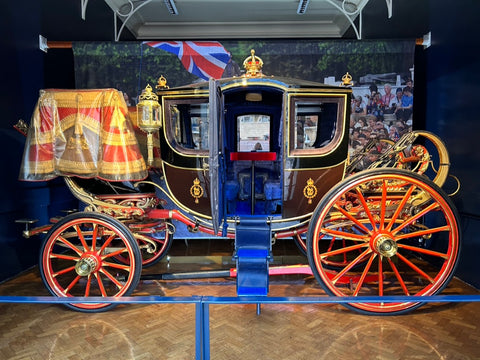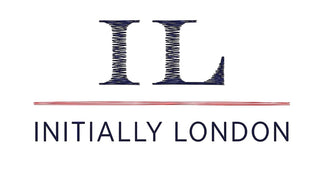We've launched a set of 6 special edition napkins to commemorate the coronation of King Charles III. Each embroidered motif was selected and sewn by our in-house team on our gorgeous 100% linen napkins. How did we choose the motifs? Well we're glad you asked... here's the story behind each one.
1. The Coronation Emblem
This is an obvious choice. The emblem, according to its designer, Sir Jony Ive KBE, "was inspired by King Charles’ love of the planet, nature, and his deep concern for the natural world. [It] speaks to the happy optimism of spring and celebrates the beginning of this new Carolean era for the United Kingdom.

2. The official monogram of King Charles III
Again, an obvious choice as we clearly love a good monogram and relish any opportunity to use one. It is only royal monograms that can have a crown above them, and the crown in the ruling monarch's monogram is the one used for his or her coronation.
In this case, it's the St Edwards Crown. The R in Charles III's monogram stands for Rex which is of course Latin for "king". The monogram style is technically a cypher but that's getting a little too technical... we'll blog about that distinction another time.

The most common place to see the monarch's monogram in everyday use is on postboxes. There are still boxes in use from the reign of Queen Victoria, Edward VII, George V and VI. The original cyphers remain until boxes need to be replaced or new boxes are needed, so you won't be seeing many Charles III postboxes anytime soon.

3. The Union Jack
Of course we couldn't exclude the Union Jack from the collection. In our Platinum Jubilee Napkins we included Union Jack-themed bunting but as this is a more solemn and august occasion, we went straight for the real deal.
The Union Jack's design is fascinating.. both simple and elegantly complex at the same time. We love this simple explanation from Sketchplanation:

The King is sovereign of all the British nations but only Scotland doesn't recognise the full powers of the monarch.
In 1603 King James VI of Scotland succeeded to the English Crown. The Union of the Crowns was followed by the Union of the Parliaments in 1707 which provided for certain powers to endure in Scotland. To this day, the Scottish Parliament determines much of Scotland's legislation but the two Crowns remain united under a single Sovereign, the present King.
4. The Regalia
Regalia is the set of emblems or paraphernalia indicative of royal status. In the UK, this consists of the crown, orb and sceptre, as well as other pieces in the Crown Jewels collection. They are symbols of over 800 years of monarchy, and the coronation regalia are the only working set in Europe.

Most of the collection, which is housed in the Jewel House at the Tower of London, dates from around 350 years ago when Charles II ascended the throne. The medieval and Tudor egalia had been sold or melted down after the monarchy was abolished in 1649 during the English Civil War. Only four original items survive: a late 12th-century anointing spoon (the oldest object) and three early 17th-century swords. None of the crowns survived intact but many of the jewels did and were reincorporated in later crowns. We'll get to that shortly.
At a coronation, the monarch is anointed on the hands, breast and head by the Archbishop of Canterbury using holy oil poured from an ampulla into the Coronation spoon. The anointing is the most sacred part of the coronation ceremony, and takes place before the investiture and crowning.
He is then dressed in the coronation robe and presented with several ornaments symbolising the spiritual nature of kingship. These include the spurs, swords and armills, followed by the orb, a ring and the sceptres.
Our embroidered collection of regalia includes just the crown, orb and sceptre as these are the most recognised symbols of the monarchy, and here's why...
The Orb is a representation of the sovereign's power. It symbolises the Christian world with its cross mounted on a globe, and the bands of jewels dividing it up into three sections represent the three continents known in medieval times.

Mounted with clusters of emeralds, rubies and sapphires surrounded by diamonds and pearls. A cross on the top is set with with diamonds with a sapphire in the centre on one side and an emerald on the other, and with pearls at the angles and at the end of each arm.
During the coronation service, the Orb is placed in the right hand of the monarch as he or she is invested with the symbols of sovereignty. It is then placed on the altar before the moment of crowning
Next is the Sceptre. There are actually two sceptres used in the coronation ceremony. The first represents the sovereign's spiritual role with the dove at the top symbolising the Holy Ghost. Traditionally it has been known as 'the Rod of Equity and Mercy'.

The Sovereign’s Sceptre with a cross at the top is the other, representing the temporal power of The King or Queen, and is associated with good governance.
The Sovereign's Sceptre holds the world’s largest diamond, the Cullinan I. Found in South Africa in 1905, it was gifted to Edward VII in 1907 to help mend relations between Britain and South Africa after the Boer War. Then it was cleaved in Amsterdam into nine parts, and 97 smaller brilliant diamonds. The largest part, 530 carats, was set into the sceptre in 1910 and first used at George V’s coronation.
.

Finally he is crowned with St Edward's Crown which is a solid gold crown decorated with rubies, amethysts and sapphires and weighs over 2kg. It was made for the Coronation of Charles II in 1661 as a replacement for the medieval crown melted down in 1649, after the execution of Charles I.
.

At the end of the Coronation ceremony, the St Edward's Crown is exchanged for the lighter Imperial State Crown, which is worn by the monarch to leave Westminster Abbey. It is also worn at the annual State Openings of Parliament.

The Imperial State Crown was made for the Coronation of King George VI in 1937. It is set with 2,868 diamonds, as well as several famous jewels including the St Edward's Sapphire, said to have been worn in a ring by Edward the Confessor. The crown also includes the Cullinan II diamond, the second largest stone cut from the great Cullinan Diamond, the largest diamond ever discovered.
Collectively or even individually, the Crown Jewels are so valuable that they have their very own coach by which they are transported from the Tower of London to Parliament and Westminster Abbey.
We recently visited the Royal Mews where the coaches are kept to see for ourselves. And indeed, it's called Queen Alexandra's State Coach and it has a little table in the centre, illuminated to enhance the jewels' sparkle, where the crown is placed for travel:
.

This coach travels just in front of the monarch's own coach, and can be seen each year as it travels from the Tower of London to Parliament for the State Opening of Parliament. The Crown Jewels are entitled to a Household Cavalry escort and a royal salute.
5. The Coronation Coach
So of course we had to include the coach in which King Charles will travel to Westminster Abbey for the Coronation. If you haven't ever visited the Royal Mews, it is really fascinating and definitely should be on your list for a fun afternoon in London, particularly if you're a horse lover.
The most spectacular coach there is of course the Gold Coronation Coach made in the 1760 for Charles III. It is truly unbelievable... it looks like a prop from a Disney princess film but, on closer inspection, it's a spectacular work of art and craftsmanship that makes it the most spectacular royal coach in the world.
.


Queen Elizabeth II used this coach for her own coronation and it was pulled by a team of 8 Windsor Grey horses, one of two breeds which are stabled at the Royal Mews. Evidently it is so heavy it can travel no faster than a horse's walking pace and it has to have a groom walking next to each horse. Whether King Charles will choose to use it for his own Coronation remains to be seen.
We chose a relatively more sedate carriage for our linen napkin collection, modelled on the stunning Diamond Jubilee State Coach, the newest of all the horse-drawn coaches.
.


6. Westminster Abbey
Since the whole event takes place in Westminster Abbey and always has done, we of course had to include this iconic building. For over 1000 years, coronations, royal weddings, and the burials of kings, queens, statesmen and soldiers, poets, heroes and even a few villains have taken place here.
.

There have been thirty eight coronation ceremonies for reigning monarchs held at the Abbey.The Coronation Chair in St George’s Chapel is one of the most precious and famous pieces of furniture in the world. It has been the centrepiece of coronations for over 700 years,
.

The Coronation Chair was made by order of King Edward I to hold the famous Stone of Scone under the seat. King Edward brought the 152 kg sandstone from Scotland to the Abbey in 1296. For centuries it had been an object of veneration to the Scots and their kings were crowned on it.
Fast forward nearly 800 years to when Scottish Nationalists stole the stone on Christmas Day in 1950. After its recovery a few months later, it was kept in the vault in which it had been stored during the Second World War and was not replaced in the Chair until February 1952, after elaborate precautions had been taken for its future safety.
However, on 3rd July 1996 the Prime Minister John Major announced that the Stone of Scone would be returned to Scotland by the end of the year, returning to the Abbey only for coronations. It can now be seen in Edinburgh Castle.
So the Coronation Chair, once the oldest piece of furniture in England still used for the purpose for which it was originally built, now stands empty after 700 years. Whether the Stone will be returned for the first time for a coronation is the question...
.

So here is the full set of Coronation Napkins!
We hope that they'll help mark this historic occasion in an elegant and timeless way. Embroidered linen napkins become heirloom pieces that can be shared by generations.
.
 |
 |
 |
 |
 |

|
